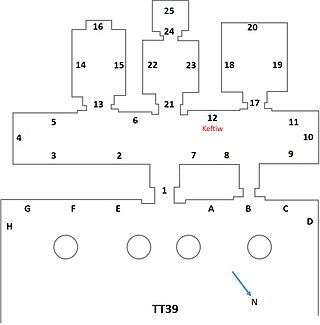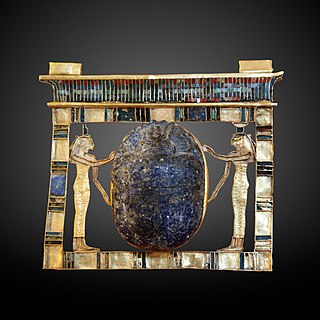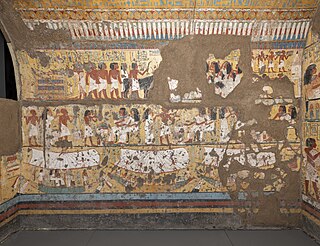
Deir el-Bahari or Dayr al-Bahri is a complex of mortuary temples and tombs located on the west bank of the Nile, opposite the city of Luxor, Egypt. This is a part of the Theban Necropolis.
Naguib Kanawati is an Egyptian Australian Egyptologist and Professor of Egyptology at Macquarie University in Sydney, New South Wales, Australia.
Deir El Bersha is a Coptic village in Middle Egypt, in the Minya Governorate. It is located on the east bank of the Nile to the south of Antinoöpolis and almost opposite the city of Mallawi. During the pharaonic period, there was a vast cemetery, which is most well known for its decorated Middle Kingdom tombs on the north flank of Wadi Nakhla.
Deir el-Gabrawi is a village in Upper Egypt. It is located on the east bank of the Nile, directly east of the city of Manfalut, in the Asyut Governorate.
The necropolis of Meir is an archaeological site in Middle Egypt in the Asyut Governorate located on the west bank of the Nile. Here are the graves of the nomarchs, mayors and priests of Cusae from the ancient Egyptian Old and Middle Kingdom.

TT1 is the burial place of the ancient Egyptian official Sennedjem and members of his family in Deir el-Medina, on the west bank of the Nile opposite Luxor. The funerary complex consists of three pyramid-shaped chapels dedicated to, from south to north, Sennedjem's father or brother, Sennedjem himself, and Sennedjem's son Khonsu. Of the three shafts associated with the chapels, only the shaft in front of Sennedjem's chapel was unrobbed. It leads to a series of underground rooms, including the extensively decorated burial chamber.

Theban Tomb 69 is located in Sheikh Abd el-Qurna, part of the Theban Necropolis, on the west bank of the Nile, opposite Luxor. It is the burial place of the ancient Egyptian official named Menna, whose titles included ‘Overseer of Fields of Amun’, and ‘

The Theban Tomb TT39 is located in El-Khokha, part of the Theban Necropolis, on the west bank of the Nile, opposite to Luxor. It is the burial place of the ancient Egyptian official, Puimre.

Paser was an ancient Egyptian noble who served as vizier during the reigns of Seti I and Ramesses II in the 19th Dynasty. He would later also become High Priest of Amun.

Theban Tomb TT2 is the burial place of the ancient Egyptian official Khabekhnet and his family in Deir el-Medina, part of the Theban Necropolis, on the west bank of the Nile, opposite to Luxor. The two adjoining tomb-chapels were intended for Khabekhnet and his brother Khonsu; Khonsu was ultimately buried nearby in their parents funerary complex, TT1, possibly due to unstable rock in the tomb below his chapel. Only the southern chapel was decorated, and only the subterranean rooms of the northern chapel, TT2B, were decorated. The chapel's relief decoration is shared equally between Khabekhnet and Khonsu but the completed burial chamber of TT2B mentions only Khabekhnet. Fragments of burial equipment indicate he was buried there along with his wife, Sahte; the robbed tomb was reused in antiquity and later became a hermitage in the Christian era.

The tomb of Kha and Merit, also known by its tomb number Theban Tomb 8 or TT8, is the funerary chapel and burial place of the ancient Egyptian foreman Kha and his wife Merit, in the northern cemetery of the workmen's village of Deir el-Medina. Kha supervised the workforce who constructed royal tombs during the reigns of the pharaohs Amenhotep II, Thutmose IV and Amenhotep III in the mid-Eighteenth Dynasty of the early New Kingdom of Egypt. Of unknown background, he probably rose to his position through skill and was rewarded by at least one king. He and his wife Merit had three known children. Kha died in his 60s, while Merit died before him, seemingly unexpectedly, in her 20s or 30s.

The Theban Tomb TT57 is located in Sheikh Abd el-Qurna. It forms part of the Theban Necropolis, situated on the west bank of the Nile opposite Luxor. The tomb is the burial place of the ancient Egyptian official Khaemhat, who was royal scribe and overseer of double granary, during the reign Amenhotep III. The relief decoration of the tomb is regarded as the best of New Kingdom art.

Kaikhenet was an ancient Egyptian local governor in the 10th Upper Egyptian province; the latter called Wadjet in the Egyptian language. Kaikhenet lived at the beginning of the Fifth Dynasty and is known from his decorated rock cut tomb at Hemamieh. Decorated rock cut tombs are very rare in the Egyptian provinces before the end of the Fifth Dynasty. The tombs at Hemamieh are an exception. They belong to the earliest ones in the provinces. Kaikhenet (II) was most likely the son of another governor also called Kaikhenet (I). The father-son relation of both governors is not fully certain but in the tomb of Kaikhenet (I) is depicted a son called Kaikhenet, that might be Kaikhenet (II). If this identification is correct, his mother was most likely Khentkaus, the wife of Kaikhenet (I). Kaikhenet's (II) wife was a woman called Iufi. She bore several titles, including acquaintance of the king, priestess of Neith, north of the wall, priestess of Hathor, lady of Denderah, and king's daughter . Two sons are known. Rahotep became perhaps the successor of Kaikhenet as local governor. The other son was called Kaires and bore the simple title scribe. His daughters are called Nefertkau and Djefa.

Amenhotep was an ancient Egyptian official and chief physician of the early 19th Dynasty. He is mainly known from his decorated tomb chapel that was excavated in 1913–14 by Ahmed Bey Kamal at Asyut, in Middle Egypt.
The Tomb of 'Ip is an ancient Egyptian tomb chapel that was discovered in 1936 in El Saff, 17 km north of Atfih in Middle Egypt. The decoration of the tomb chapel was copied in the following years, but since then the location of the tomb was lost. The records were published in 1995 by Henry George Fischer in a monograph. No plan was recorded.

Khety was an ancient Egyptian local governor of the Oryx nome in Middle Egypt in the Twelfth Dynasty. He is only known from his decorated tomb chapel at Beni Hasan. In the decoration of his tomb chapel appear several inscriptions providing the name and titles of Khety. He was great overlord of the entire Oryx nome. This is the main title of the local governors of the Oryx nome. Other titles include count (Haty-a), royal sealer, sole friend, king's acquaintance, who is in the chamber, who belongs to Nekhen and overlord of Nekheb, but also overseer of troops at all secret places. Not much is known about his family. His father was a person called Baqet, his wife was called Khnumhotep and there is one son attested with the name Khety. Naguib Kanawati wonders whether Khety was the son of Baqet III. The latter's tomb and those of Khety share the same plan and are close to each other.

TT338 is the burial place of the ancient Egyptian artist Maya and his wife Tamyt in Deir el-Medina near modern Luxor, Egypt. Maya was titled "outline-draughtsman of Amun" and was active in the late Eighteenth Dynasty. The chapel was probably discovered in the early 1900s. The painted interior depicts the funerary procession and feasts of the deceased; the decoration was detached by the discoverers and is housed today in the Museo Egizio in Turin, Italy.

Ibi was an Ancient Egyptian Nomarch of the 6th Dynasty at the end of the Old Kingdom, around 2200 BC. He is well known from his rock cut tomb at Deir el-Gabrawi.

Inti was an ancient Egyptian provincial official who lived in the 5th Dynasty and who is known from his rock-cut tomb at Dishasha. The tomb is famous as it shows on one wall the siege of a Levantine fortress or town.

Shedu also called Iteti was an ancient Egyptian provincial official who lived in the 6th Dynasty and who is known from his rock-cut tomb at Dishasha.















